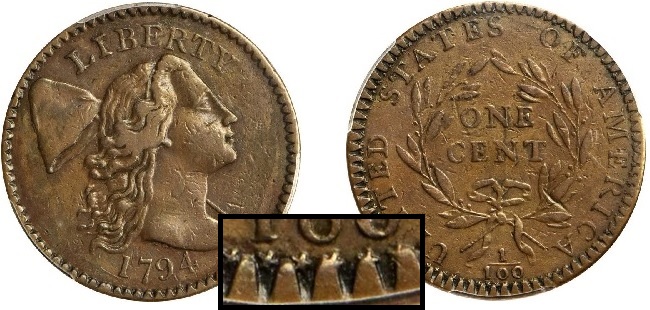1794 Liberty Cap Cent, Starred Reverse
Among the most famous of early United States coins is the 1794 “Starred Reverse” Liberty Cap cent. The rarity and mysterious nature of this coin has propelled it to the forefront of numismatic fascination, a post it has occupied for about 150 years.(1)
Advanced collectors refer to it as Sheldon-48 (S-48 for short), from Dr. William H. Sheldon’s book Penny Whimsy, where he cataloged all the large cent varieties of 1793-1814.
The S-48 is noted for having 94 very tiny five-pointed stars located somewhat between the dentils (toothlike devices encircling the rim of some coins) on the reverse. The discovery of the stars is credited to Henry Chapman in 1877. Yes, it took 83 years before anyone noticed!(2)
Despite extensive research, investigators have never determined the purpose for stars’ existence, nor exactly how they got there. Several theories have been proposed:
- One explanation put forth in 1880 is that the stars only were placed on pattern coinage planchets from 1792 that never got used. These were pulled from storage and overstruck with the 1794 Liberty Cap cent dies.(3)
- The inconspicuous stars were put there as part of an anti-counterfeiting measure that never was adopted.
- The engraver was planning to use a ring of stars as the border, but then decided that would be unsatisfactory, so he added denticles to improve stacking, which partially covered or eradicated some of the underlying stars.(4)
One thing nearly everyone agrees on is the stars were not intended as an integral feature of the 1794 cent reverse design. There are 94 stars but only 83 dentils. To appear properly balanced, the number of stars and dentils should match, so that the stars are centered between the dentils. This has led researchers to conclude the stars were originally created for some other reason, yet ended up on a few 1794 cents.(5)
How many Starred Reverse cents were struck? Once again, no one knows. Of the 918,521 cent output in 1794, the percentage of the S-48 variety was most assuredly small, explaining why only about 60 examples are known today.(6)
Almost all Starred Reverse cents show weakness along the upper right hand area of the coin. This occurred when shortly after being placed into service, the reverse die was bent in a line from 10:00 to 4:00 o’clock. Stars at 1:00 rubbed off soon after being released into circulation, while those at 7:00 can still be seen on even the heaviest worn specimens.
Because the S-48 reverse die was damaged and was probably retired early in its life may explain the extreme scarcity of 1794 Starred cents. Examples with all or most stars visible command significant premiums.
Perhaps someday we will uncover long lost government archives detailing what the early Mint had in mind with these tiny stars. No matter, because the Starred Reverse cent will continue to entice informed collectors, just as it has done since 1877.
| Estimated survivors in all grades: 60 ?
The survivor estimate from PCGS represents an average of one or more experts' opinions as to how many examples survive of a particular coin in all grades. Survival estimates include coins that are raw, certified by PCGS, and certified by other grading services. Learn more at PCGS. |
| PCGS Rarity Scale: 8.4 ?
The 'PCGS CoinFacts Rarity Scale' assesses the relative rarity of all U.S. coins, based on estimated surviving examples. The scale runs from 1.0 to 10.0. The higher the number, the rarer the coin.
Learn more at PCGS. |
| Click HERE to check for availability on eBay** |
Preview of eBay selection (try HERE link above before moving on):
 |
|
| Trendline Avg = 9.38 | CLASSIC RARITY |
Historic Value Trend Charts:
| Last updated 11-11-24 | Return to Key Date Coin List | |
| Compare to Common Date Coin of Same Type | ||
|
|
||
| Download Charts to Your Computer | ||
Sources
1. Garrett, Jeff and Guth, Ron. 100 Greatest U.S. Coins, 5th ed. Pelham, AL: Whitman Publishing, 2019.
2. Stack's Bowers Galleries. 1794 Liberty Cap Cent. S-48. Starred Reverse. Aug 2020 Auction.
3. Heritage Auctions. 1794 1C Starred Reverse. S-48. Feb 2008 Auction.
4. Garrett, Jeff and Guth, Ron. 100 Greatest U.S. Coins, 5th ed. Pelham, AL: Whitman Publishing, 2019.
5. Stack's Bowers Galleries. 1794 Liberty Cap Cent. S-48. Starred Reverse. Aug 2020 Auction.
**Many very fine coin dealers sell on eBay. At any point in time, there may be over one million search results for United States coins. This includes quite a few of the recommendations on our Key Date Coin List.
If you’re thinking about purchasing a rare coin, eBay is certainly worth a look. For your convenience, the links from this site to eBay are coded to bring up only coins certified by PCGS and NGC.
As is always, always the case, never buy a valuable coin from a seller whose trustworthiness cannot be verified. Learn more about this at our chapter Best Places to Buy Coins, which also has a section on doing business on eBay.
In the interest of full disclosure, Rare Coins 101 receives a small commission anytime someone connects to eBay from this site and purchases something.
Coin images by Stack's Bowers Galleries.


